Vol 5 No. 18 TROPIC LIGHTNING NEWS May 11, 1970
Index
‘Encircled’ GIs Overrun Charlie
By RICH FITZPATRICK
WAR ZONE C - 25th Infantry Division soldiers killed 26 enemy soldiers in a
vicious battle recently during which they were briefly surrounded.
The “Bobcats” of Alfa Company, 1st Battalion (Mech.), 5th Infantry, were
proceeding on a morning reconnaissance when they noticed a trail. Unlike the
other paths in the area that were overgrown with weeds, this was a well-beaten
trail with numerous footprints less than 12 hours old.
Leaving a small security element behind, the company’s third platoon followed
the enemy signs north as the first platoon headed south down the path.
After traveling about 200 yards, the third platoon entered a clearing and
spotted five enemy. As the Bobcats engaged the enemy, they received heavy small
arms fire.
The other platoon returned to their APCs and moved out to help. With .50
caliber machine guns blazing, the tracks laid down a wall of fire as the men
swept through a heavily-entrenched enemy bunker complex.
As the Americans began to take casualties, two APCs transported the wounded
to a secure area where a dust-off chopper picked them up. But as they started
to return to the rest of the platoon, they received rocket-propelled grenade
(RPG) fire.
The company commander, Captain Gerald M. Bonti, of Charlotte, N.C., was asked
by the C & C ship above the contact area what direction the fire was coming
from.
“From the north, west, south, and east,” he replied laconically.
Bonti then regrouped his forces and called in artillery and a light fire
team. After a half hour of indirect fire, the Bobcats once again moved into the
area.
They slowly moved through the bunker line only to find another one ahead of
them. The heavily-entrenched enemy force continued to fight off the Bobcats
with heavy machine gun, small arms and RPG fire.
Lieutenant Gail Keller, of Baltimore, Md., recalled an RPG round hitting his
track and said, “All I can remember is a big explosion and shrapnel bouncing off
my flack jacket.”
Soon the Bobcats pulled back to the original position and called in an air
strike. After an hour-long strike, the men returned to the scene of the
battle. This time there was little opposition. The Tropic Lightning troopers
swept quickly through the bunkers before sundown, finding five AK-47 rifles, an
RPG launcher, two machine guns, and numerous pieces of individual equipment and
ammunition.
Reflecting on the contact a few days later in Dau Tieng, Staff Sergeant Pat
Cardona, of Winfield, Kan., commented, “Not even half the men had ever been in a
firefight before, but they fought like experienced veterans.
Enemy Trapped Despite Detour
By SGT DAN DELANEY
TAY NINH - Twelve Rangers from the 25th Division’s Company F, 75th Rangers,
recently killed seven enemy soldiers in the Crescent woods area.
Claymores and other explosives were rigged to detonate into a kill zone.
“We spent over two hours setting everything up along a well-used trail,” said
Sergeant Joe Hard, of Austin, Tex., the team leader. “When they (the enemy)
came along, they took an old APC track trail that led them nearly 30 meters from
our ambush site, but we were able to blow the ambush on them anyway.”
Shrapnel and claymore fragments ripped through the kill zone.
“It took ten minutes or more for the smoke and dust to clear away enough to
see anything,” said Private First Class Kenneth Palmer, of Idabell, Okla.
Two dead enemy soldiers were found on the track trail initially while blood
trails led the Rangers to five additional enemy bodies.
“They must have been a resupply group,” said Hard, “as there were several
straw or bamboo bushels of rice and mangoes scattered all over the place.”
Nine Enemy Killed
Warriors Capture Cache
FSB KIEN - 25th Infantry Division soldiers killed nine enemy recently, while
confiscating a small cache south of here.
“It started out like any other day. We were to go on a short RIF
(reconnaissance in force) and then head back to Kien,” said Specialist 4 Joe
O’Connor, of Boston, the senior medic of Charlie Company, 2nd Battalion, 12th
Infantry.
But what began as a routine mission ended as the last battle for the slain
enemy. Seven AK-47 rifles, along with an RPG-2 launcher, were captured.
Inserted south of Kien, the “Warriors” of Company C formed two columns and
started into extremely dense brush.
“The going was rough and slow for awhile,” said 1st platoon Sergeant Howard Williams, of Atlanta. “But we finally reached a clearing.”
After breaking for chow, the 1st platoon set up as a blocking force while the
other two platoons began a series of sweeps. As the third platoon came upon
another clearing, things began to jump.
“We could hear voices and saw what appeared to be a VC sitting on a bunker
near the woodline,” said O’Connor.
“When an attempt to get the VC to rally failed, and we began receiving small
arms fire, we pulled back and called for some help,” said 3rd platoon Sergeant
James Ross, of Sturdevant, Wis.
Help soon arrived in the form of a Cobra gunship from the 187th Assault
Helicopter Company and a Huey gunship from the 116th Assault Helicopter Company.
Two volunteers from the 3rd platoon crept near the bunker from which the fire
was coming and tossed fragmentation grenades into the entrance. The enemy
appeared silenced, but as the men of Company C moved in for a closer look, a
light machine gun opened up from another position.
The Tropic Lightning troopers again pulled back and called for Sergeant John
Nash, of Fayetterville, N.C., whose accuracy with the Light Anti-tank Weapon
(LAW) was well known throughout the company. As one of the gunship’s
doorgunners tossed more hand grenades onto the enemy, Nash pounded the enemy
positions.
“By then it was getting late,” said Williams, “so we withdrew and set up
several ambushes around the contact area.”
The night remained quiet.
In the morning, the Warriors swept the area, finding nine enemy bodies in the
bunker where the first enemy firing came from the day before. Also in the same
bunker were seven AK-47 rifles and the RPG-2 launcher.
To Win a War:
Go to the Movies
By SP4 BRIAN FLAHERTY
TAY NINH - An American institution - the drive-in movie - is winning new
friends for the 25th Division among the citizens of Tay Ninh.
Periodically, a PSYOPS (Psychological Operations) team from the 3rd
Battalion, 22nd Infantry “Regulars,” sets up an outdoor movie.
The film themes vary. But knowing that a point can be made as easily with a
grin as a frown, the Regulars frequently show a movie in which two Vietnamese
actors portray bumbling Viet Cong in an Asian take-off on Laurel and Hardy.
Another film that Vietnamese viewers seem to appreciate is a more serious
portrayal of an average Vietnamese family. While the mother and father are
trying desperately to raise their sons properly, they find themselves competing
against Communist influence. One boy leaves his parents’ home to become a Viet
Cong, and tragedy follows.
Latest attendance figures show an average of 1,200 people attend each show.
Delighted children eat candy, guzzle soda and make plenty of noise while the
adults take a more serious look at the shows.
One “theater manager” noted that Vietnamese teenagers enjoy drive-ins as much
as their American contemporaries. Is there any of the “hanky-panky” that one
finds at drive-ins in “the world”? Apparently not. “After all,” he said,
“they’re using Hondas, not Chevys.”
| DROPPING IN ON CHARLIE -- A five-ship lift circles over the Saigon River carrying C Company, 2nd Battalion, 12th Infantry troops to their LZ in the Trapezoid. (Photo by SP4 Jim Williams) |
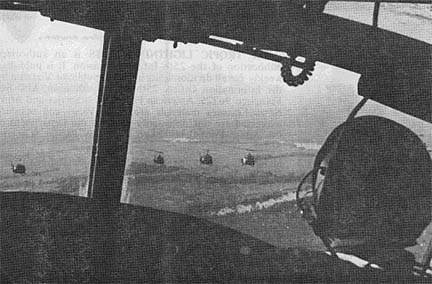 |
| SAIGON -- Clever these Charlies. Be wary GI. The enemy can kill you a
lot of ways. Military intelligence indicates that the enemy has constructed a large number of cigarette lighter bombs that he plans to distribute in places frequented by U.S. personnel in the III Corps area. Charlie hopes you will find the Zippo-type lighter, pick it up thinking some guy lost his fire and that you have a new souvenir. It will explode when the flint wheel is turned and can kill the user and anyone standing near him. If you find a lighter that looks suspicious or is unattended, do not pick it up. Alert others and call the E.O.D. team. DEROS. Do it the safe way. |
Page 2 TROPIC LIGHTNING NEWS May 11, 1970
Decorated
| SILVER STAR | |
| LTC George A. Custer, HHC, 2d Bn, 27th Inf | SP4 Kenneth E. Laswell, Co D, 4th Bn, 23d Inf |
|
DISTINGUISHED FLYING CROSS |
|
| MAJ Ronald C. Crowl, Co B, 25th Avn Bn CPT Richard L. Campbell, Co A, 25th Avn Bn CPT Bruce J. Fullerton, Co B, 25th Avn Bn CPT William C. Melvin, Co B, 25th Avn Bn CPT Philip A. Tocco, D Trp, 3d Sqdn, 4th Cav 1LT Charles L. Gant, Co B, 25th Avn Bn 1LT Steve Hickman, Co B, 25th Avn Bn 1LT Gary Manso, Co B, 25th Avn Bn CW3 Marvin H. Spitzer, Co B, 25th Avn Bn |
CW2 Michael Finnigan, Co B, 25th Avn Bn CW2 John A. Riley, Co B, 25th Avn Bn WO1 James F. Carnathan, D Trp, 3d Sqdn, 4th Cav WO1 Rog Johnson, D Trp, 3d Sqdn, 4th Cav WO1 Dan Lohwasser, D Trp, 3d Sqdn, 4th Cav WO1 Robert V. Rector, Co B, 25th Avn Bn WO1 Kenneth L. Strand, D Trp, 3d Sqdn, 4th Cav WO1 Michael B. Wilson, D Trp, 3d Sqdn, 4th Cav SP5 Steven L. Dobry, D Trp, 3d Sqdn, 4th Cav SP4 Michael R. Bagley, D Trp, 3d Sqdn, 4th Cav |
| BRONZE STAR |
|
|
LTC Thomas E. Hendricks, HHC, 1st Bde MAJ James F. Norman Jr, HHC, 1st Bde 2LT Earnest Hardimon, Co C, 4th Bn, 23d Inf 2LT Kenneth Sparks, Co B, 2d Bn, 12th Inf WO1 Kenneth E. Thiem, HHC, 3d Bde PSG David Jones, Co A, 4th Bn, 23d Inf PSG Freddie E. Wood, A Trp, 3d Sqdn, 4th Cav SSG Alexander J. Alcontera, B Trp, 3d Sqdn, 4th Cav SSG James M. Barnes, B Trp, 3d Sqdn, 4th Cav SSG James Chavis, Co A, 4th Bn, 23d Inf SSG Francis J. Hoyer, Co C, 4th Bn, 23d Inf SSG John W. Kopp, Co C, 4th Bn, 23d Inf SSG Lonnie W. Prosser, Co A, 4th Bn, 23d Inf SSG Harold E. Reid, Co A, 2d Bn, 14th Inf SSG Michael A. Van Houten, Co A, 4th Bn, 23d Inf SGT Robert W. Besaw, Co B, 2d Bn, 14th Inf SGT Kelly F. Coleman, Co A, 4th Bn, 23d Inf SGT Joseph F. Doucette, Co A, 4th Bn, 23d Inf SGT Frederick Fisher, Co A, 4th Bn, 23d Inf SGT Michael Keyster, Co A, 4th Bn, 23d Inf SGT Perry Lynch, Co A, 4th Bn, 23d Inf SGT Ronald A. Milford, Co B, 2d Bn, 12th Inf SGT John E. Mohler, C Btry, 7th Bn, 11th Fld Arty SGT John E. Nash, Co C, 2d Bn, 12th Inf PFC Robert L. Pyle, Co A, 2d Bn, 14th Inf PFC George A. Reischling, Co A, 3d Bn, 22d Inf PFC Jerald G. Rising, Co D, 3d Bn, 22d Inf PFC Craig Sawmiller, Co D, 3d Bn, 22d Inf PFC Craig Scroggs, Co D, 3d Bn, 22d Inf PFC Harry G. Taylor, Co D, 3d Bn, 22d Inf |
PFC Billy S. Walters, Co D, 3d Bn, 22d Inf PFC Horace P. Wembish, Co D, 3d Bn, 22d Inf PFC Raymond G. White, Co D. 3d Bn, 22d Inf SGT Charles M. Perry, Co A, 4th Bn, 23d Inf SGT Stephen Rapata, Co A, 4th Bn, 23d Inf SGT Richard E. Schline Jr, Co B, 2d Bn, 14th Inf SGT Jack Taylor, Co A, 4th Bn, 23d Inf SGT John Taylor, Co A, 4th Bn, 23d Inf SGT Richard F. Zeh, Co C, 4th Bn, 23d Inf SP4 William H. Allen, Co A, 4th Bn, 23d Inf SP4 James R. Anderson Co A, 2d Bn, 14th Inf SP4 Ferman L. Bennett, Co A, 4th Bn, 23d Inf SP4 Robert M. Braun, Co B, 2d Bn, 12th Inf SP4 Salvador Castillo, HHC, 1st Bde SP4 William Chang, Co B, 2d Bn, 12th Inf SP4 Ross Ciccarello, C Btry, 7th Bn, 11th Fld Arty SP4 L. C. Clemons, Co A, 4th Bn, 23d Inf SP4 Edward J. Cooper, HHC, 1st Bde SP4 Donald Epling, Co A, 4th Bn, 23d Inf SP4 John T. Farone, Co B, 2d Bn, 14th Inf SP4 George Fell, Co A, 4th Bn, 23d Inf SP4 George Fell, Co A, 4th Bn, 23d Inf SP4 David B. Grey, Co B, 2d Bn, 14th Inf SP4 Robert Hamilton, Co A, 4th Bn, 23d Inf SP4 Carol G. Haverkamp, Co D, 3d Bn, 22d Inf SP4 John H. Hyatt, Co C, 4th Bn, 23d Inf SP4 Patrick MacDonald, Co A, 4th Bn, 23d Inf SP4 Pedro D. Martinez, Co A, 4th Bn, 23d Inf SP4 Charles Mayzlik, HHC 2d Bn, 22d Inf |
Trouble Afoot
Giving Your Toes a Break
Foot care sometimes means more than just keeping your feet dry. It also means
giving them protection.
In one recent incident, a private was helping unload 55-gallon drums full of
MOGAS from a two and one-half ton truck. One of the drums slipped from the
grasp of another man, rolled off the truck, landed on the private’s foot and
fractured it.
Another man, an artillery sergeant at Fire Support Base Devins, was
inspecting his gun section’s ammunition supply when the section received an
alert for a fire mission. He decided to help with the mission by carrying a
projectile to the gun. In the dark, he stumbled and dropped the 95-pound
projectile on his foot. Unfortunately, he was wearing only shower shoes.
The first accident easily could have been prevented if a little common sense
had been used - like not standing too close to a heavy object which might fall
at any moment.
The second foot injury might never have happened had the sergeant been
wearing his combat boots. In the first place, shower shoes do not lend
themselves to sure-footedness. And, of course, they don’t provide much
protection.
You only get one set of feet. Give them the protection they deserve.
Units Surpass Re-Up Goals
Three 25th Infantry Division units recently won Tropic Lightning Quarterly
Reenlistment Awards. The winners were chosen from separate categories for the
third quarter of the 1970 fiscal year.
The winner in the “Maneuver Battalion” category was 2d Battalion, 14th
Infantry. The battalion reenlisted 141 per cent of its assigned objective for
the third quarter. It is the only unit in the Division which has attained or
exceeded its reenlistment objectives every month since July 1969.
The 725th Maintenance Battalion rated first for “Combat Support Battalion.”
The “Service to the Line” battalion reenlisted 80 per cent of its assigned
objective, setting a Division record for a combat support unit.
In the “Separate Companies” section, Company F, 75th Infantry (Rangers), was
the winner. The company, which is comprised only of volunteers in the first
place, reenlisted 100 per cent of its assigned objective for the quarter. All
those who reenlisted asked to remain in their present duty assignments.
Each of the winning units received a plaque which rotates to new winners
quarterly.
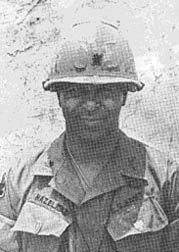 |
Lieutenant Colonel John E. Hazelwood recently assumed command of 3d Battalion, 22d Infantry. He arrived from the 199th Light Infantry Brigade where he served as brigade executive officer. LTC Hazelwood replaces LTC Warren A. Jones. |
Tropic Lightning Tots
The Commanding General Welcomes
The Following Tropic Lightning Tots
To The 25th Infantry Division – As
Reported By The American Red Cross.
Born To:
|
Apr 15 |
Apr 19 |
The TROPIC LIGHTNING NEWS is an authorized publication of the 25th Infantry Division. It is published weekly for all division units in the Republic of Vietnam by the Information Office, 25th Infantry Division, APO San Francisco 96225. Army News Features, Army Photo Features, Armed Forces Press Service and Armed Forces News Bureau material are used. Views and opinions expressed are not necessarily those of the Department of the Army. Printed in Tokyo, Japan, by Pacific Stars and Stripes.
MG Edward Bautz, Jr . . . . . . Commanding General
MAJ Warren J. Field . . . . . . Information Officer
1LT John Caspari . . . . . . . . . Officer-in-Charge
SSG Stephen F. Veroczi . . . . NCOIC
SP4 Charles C. Self . . . . . . . . Editor
SP5 Gary D. Sciortino . . . . . Assistant Editor
PFC Joseph V. Kocian . . . . . Production Supervisor
BATTALION CORRESPONDENTS
| SGT Bill Obelholzer SP4 Jim Williams SGT Wally Baker SP4 Greg Stanmar SP4 Doug Sainsbury SP4 Ken Barron SP4 Greg Duncan SP4 Brad Yaeger SP4 Frank Rezzonico SP4 Dan Neff SP4 Henry Zukowski, Jr |
4/23 2/12 2/34 2/14 2/77 1/8 2/27 1/27 1/27 7/11 2/22 |
SP4 Joe O'Rourke PFC Ray Byrne SGT William E. Zarrett SP4 Robert Caplan SP4 Brian Flaherty SP4 Rich Fitzpatrick PFC Rob Lato SP4 Frank Salerno SP4 Lawrence Merritt SP4 William McGown |
3/4 2/14 4/9 4/23 3/22 1/5 2/27 2/22 4/9 DivArty |
Page 3 TROPIC LIGHTNING NEWS May 11, 1970
Chopper Survey
By SP4 KEN BARRON
BEARCAT -- After moving into a new area of operations south of here, the 25th
Division’s 1st Battalion, 8th Artillery was faced with the task of surveying
artillery target areas located in dense jungle areas and roamed by enemy
patrols.
The heavy undergrowth and triple-canopied foliage, not to mention possible
enemy ambushes and booby traps, made the use of conventional survey methods
impossible.
Rising to the challenge, the “Automatic Eighth’s” survey section went
“sky-high” hurdling the problem. Major Frank Serpice of Colorado Springs,
Colo., the battalion’s executive officer, and Captain Ronald Kendis from Los
Angeles, the battalion’s intelligence officer, introduced a system never used by
the 25th Infantry Division Artillery and only rarely used by other Army
artillery units.
Using a Light Observation Helicopter (LOH) to hover over inaccessible
geographical points, two survey teams shot azimuths using the LOH as the
corresponding point, and then computed the exact location of the geographical
feature, thereby acquiring surveyed artillery targets accurate to fourteen-place
grids.
While two platoons from the 1st Battalion, 27th Infantry “Wolfhounds,”
provided physical security during the three day operation, the two Headquarters
Battery survey teams were positioned atop the peaks of two 1500-foot mountains
in the area. By using the two mountain tops, the survey will be classified,
according to National Geodetic standards, as a “first order survey,” which is
the best survey possible.
The procedure, once the surveyors had oriented themselves, called for Kendis
to fly over a predetermined geographical feature and hover, at least for a few
seconds, perpendicular to the specified feature. The pilot and Kendis could
only “eyeball” the feature, and estimate when they were perpendicular to it.
Once Kendis decided they were at the exact spot, he radioed the survey teams
and gave the command, “Mark!” Both teams shot azimuths to the hovering
aircraft. Using this method, the two azimuths intersected and the exact
location was known.
The LOH flew at an altitude of 1,500 feet, placing them at eyelevel with the
surveyors on the mountains, thus eliminating any vertical angle to be
considered in the computations.
Commending the Division Artillery LOH pilots on their flying, Kendis said,
“The pilots did an excellent job hovering over the targets and then holding for
the few necessary seconds. They also made excellent landings on the hilltops,
considering they had to fight the swirling winds and up-and-down drafts.”
The survey proved accurate when the Automatic Eighth’s B and C Batteries
fired numerous valid night registrations using the surveyed targets.
| A NEW THING TO SEE -- A Vietnamese boy watches a Bravo Company, 4th Battalion (Mech.), 23rd Infantry, track cross a new bridge built just outside his village of Ben Cau, south of Tay Ninh City. (Photo by SP4 Robert C. Caplan) |
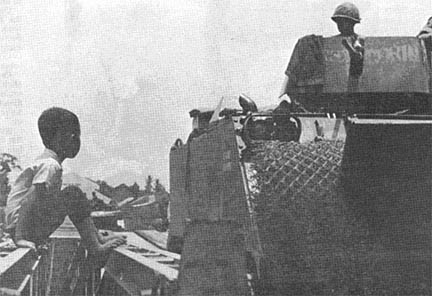 |
Strengthened for APCs
Engineers Replace Bridge
BEN CAU -- The bridge that crossed the Rach Bao River outside this village,
nine miles south of Tay Ninh City, was well-suited for oxcart and Honda traffic.
But when the 25th Division “Tomahawks” of the 4th Battalion, (Mech.), 23rd
Infantry, wanted to use the road as a route to the Straight Edge Woods -- the
site of recent heavy border fighting -- they realized an oxcart bridge wouldn’t
hold up under the weight of a company of armored personnel carriers (APCs).
The problem was quickly solved by elements of the Tropic Lightning’s 65th
Engineer Battalion. As a Chinook carried the bridge builders and a “Super Hook”
(Sky Crane, CH-54) transported a 45 foot, 14,000 pound dry-span skeleton, the
First Platoon of Alfa Engineers, led by First Lieutenant L.V. Everson
disassembled the old wooden trestle bridge.
Within an hour of the bridge’s arrival, the first 12-ton APC was on its way
across.
New Pay Scale goes into Effect
A monthly pay raise retroactive to Jan. 1 for all military personnel has
been passed by the Congress and approved by the President. It pays soldiers an
extra 8.1 percent of their present base pay.
Division Finance Officer Lieutenant Colonel J.A. Enloe said the pay raise and
back pay will be included for 25th Division soldiers with the May pay.
The back pay can be paid earlier to personnel who outprocess before the end
of May for R&R, emergency or special leave or DEROS. Those who have valid
financial hardships which early payment will help ease also may receive early
payment.
The chart below shows the new rates for each military pay grade.
Commissioned Officers
| 2 or less | Over 2 | Over 3 | Over 4 | Over 6 | Over 8 | Over 10 | Over 12 | Over 14 | Over 16 | Over 18 | Over 20 | Over 22 | Over 24 | Over 26 | |
| O-10 | 1,956.90 | 2,025.90 | 2,025.90 | 2,025.90 | 2,025.90 | 2,103.30 | 2,103.30 | 2,264.70 | 2,264.70 | 2,426.70 | 2,426.70 | 2,588.70 | 2,588.70 | 2,588.70 | 2,750.40 |
| O-9 | 1,734.30 | 1,779.90 | 1,818.00 | 1,818.00 | 1,818.00 | 1,863.90 | 1,863.90 | 1,941.30 | 1,941.30 | 2,103.30 | 2,103.30 | 2,264.70 | 2,264.70 | 2,264.70 | 2,426.70 |
| O-8 | 1,570.80 | 1,617.90 | 1,656.60 | 1,656.60 | 1,656.60 | 1,779.90 | 1,779.90 | 1,863.90 | 1,863.90 | 1,941.30 | 2,025.90 | 2,103.30 | 2,188.20 | ||
| O-7 | 1,305.00 | 1,394.10 | 1,394.10 | 1,394.10 | 1,456.20 | 1,456.20 | 1,540.80 | 1,540.80 | 1,617.90 | 1,779.90 | 1,902.30 | ||||
| O-6 | 967.20 | 1,063.20 | 1,132.50 | 1,132.50 | 1,132.50 | 1,132.50 | 1,132.50 | 1,132.50 | 1,170.90 | 1,356.00 | 1,425.30 | 1,456.20 | 1,540.80 | 1,540.80 | 1,671.30 |
| O-5 | 773.40 | 909.00 | 971.10 | 971.10 | 971.10 | 971.10 | 1,001.10 | 1,054.50 | 1,125.00 | 1,209.30 | 1,278.60 | 1,317.00 | 1,363.50 | ||
| O-4 | 652.50 | 793.80 | 847.50 | 847.50 | 862.50 | 901.20 | 962.40 | 1,016.70 | 1,063.23 | 1,109.40 | 1,140.30 | ||||
| O-3 | 606.30 | 677.70 | 723.90 | 801.60 | 839.70 | 870.00 | 916.80 | 962.40 | 985.80 | ||||||
| O-2 | 486.00 | 533.20 | 693.30 | 716.40 | 731.40 | ||||||||||
| O-1 | 417.60 | 462.60 | 577.20 |
Commissioned Officers (with 4 yr. Enlisted)
| 2 or less | Over 2 | Over 3 | Over 4 | Over 6 | Over 8 | Over 10 | Over 12 | Over 14 | Over 16 | Over 18 | Over 20 | Over 22 | Over 24 | Over 26 | |
| O-3 | 801.60 | 839.70 | 870.00 | 915.80 | 962.40 | 1,001.10 | |||||||||
| O-2 | 716.40 | 731.40 | 754.50 | 793.80 | 824.70 | 847.50 | |||||||||
| O-1 | 577.20 | 616.50 | 639.60 | 662.40 | 685.50 | 716.40 |
Warrant Officers
| 2 or less | Over 2 | Over 3 | Over 4 | Over 6 | Over 8 | Over 10 | Over 12 | Over 14 | Over 16 | Over 18 | Over 20 | Over 22 | Over 24 | Over 26 | |
| W-4 | 617.40 | 662.40 | 662.40 | 677.70 | 708.30 | 739.50 | 770.10 | 824.70 | 862.50 | 893.40 | 916.80 | 947.40 | 978.60 | 978.60 | 1,054.50 |
| W-3 | 561.30 | 609.00 | 609.00 | 616.50 | 624.00 | 669.60 | 708.30 | 731.40 | 754.50 | 777.30 | 801.60 | 832.20 | 862.50 | 862.50 | 893.40 |
| W-2 | 491.70 | 531.60 | 531.60 | 547.20 | 577.20 | 609.00 | 632.10 | 654.90 | 677.70 | 701.10 | 723.90 | 747.00 | 777.30 | ||
| W-1 | 409.50 | 469.80 | 469.80 | 508.80 | 531.60 | 554.70 | 577.20 | 600.90 | 647.10 | 669.60 | 693.30 |
Enlisted Men
| 2 or less | Over 2 | Over 3 | Over 4 | Over 6 | Over 8 | Over 10 | Over 12 | Over 14 | Over 16 | Over 18 | Over 20 | Over 22 | Over 24 | Over 26 | |
| E-9 | 701.40 | 717.60 | 734.10 | 750.30 | 767.10 | 782.10 | 823.50 | 823.50 | 903.60 | ||||||
| E-8 | 588.60 | 605.10 | 621.00 | 637.50 | 653.70 | 669.30 | 685.80 | 726.30 | 726.30 | 807.00 | |||||
| E-7 | 369.90 | 443.40 | 459.90 | 476.10 | 492.30 | 507.90 | 524.10 | 540.90 | 564.90 | 580.80 | 597.00 | 605.10 | 645.60 | 645.60 | 726.30 |
| E-6 | 318.90 | 387.30 | 403.20 | 419.70 | 435.90 | 451.80 | 468.30 | 492.30 | 507.90 | 524.10 | 532.50 | ||||
| E-5 | 275.40 | 339.30 | 355.50 | 371.10 | 395.40 | 411.60 | 427.80 | 443.40 | 451.80 | ||||||
| E-4 | 231.60 | 290.10 | 306.60 | 330.60 | 347.10 | ||||||||||
| E-3 | 167.70 | 233.70 | 249.90 | 266.40 | |||||||||||
| E-2 | 138.30 | 193.50 | |||||||||||||
| E-1 | 133.20 | 177.00 | |||||||||||||
| E-1 | 124.50 |
Page 4-5 TROPIC LIGHTNING NEWS May 11, 1970
Treat and Treatment
Medicine Show
TAY NINH – The 25th Infantry Division pacification program is serving a dual
purpose – to heal and entertain.
Operating in the various hamlets throughout the Phu Khuong District, which
includes Tay Ninh City, the “Tomahawks” of the 4th Battalion, 23rd Infantry,
conduct Medcaps while the Vietnamese Information Service (VIS) entertains the
villagers with songs and jokes.
Captain Thomas Mallison, of Bear Lake, Mich., the officer in charge of 4/23
Psyops, explained, “It is an excellent chance to work directly with the people.
They realize that we’re trying to help them, so in turn they help us.”
As the performers entertain on the back of a flat bed truck, villagers who
need medical care line up at the back ramp of “Brother Love’s Traveling
Salvation Show,” the Medcap truck of Delta Company 4/23rd.
First Lieutenant Robert Anderson, of Youngstown, Ohio, the Medical Services
Officer for the Tomahawks, is in charge of this part of the pacification
program.
“We have treated over 300 people in one day at some of the villages,” he
said. “Tuberculosis is a disease we especially look for. If they need minor
surgery, we suggest they come to our aid station. If major surgery is required,
we refer them to Tay Ninh’s hospital.”
Mallison added, “The program has been very successful. I’ve seen definite
beneficial change in the villager’s attitude towards us in the last six months.”
As the show ends, and the Medcap truck raises its ramp, the villagers return
to their homes, hopefully to tell their friends of the program.
|
Story and Photos |
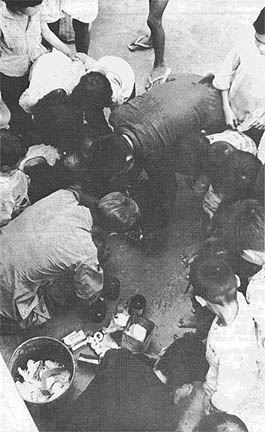 |
|
 |
|
 |
|
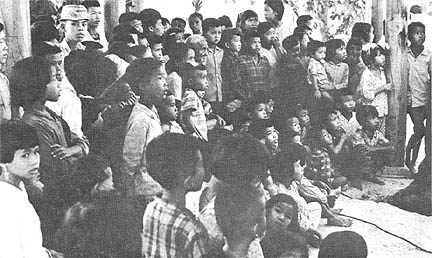 |
|
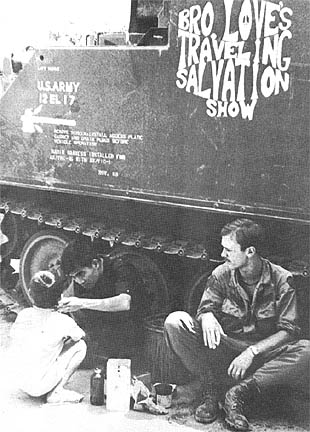 |
|
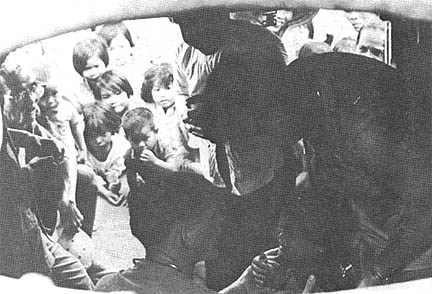 |
|
 |
Page 6 TROPIC LIGHTNING NEWS May 11, 1970
And Never Leave Camp
How to Feed a Field Army Hot Meals
BEARCAT - It was Napoleon who once said, “An army travels on its stomach.”
And for well-fed soldiers of the 25th Infantry Division, it still is true. At
Bearcat Base Camp, home of the Division’s 2d Brigade, the 4th Battalion, 9th Infantry “Manchu” mess
hall feeds the troops.
“We feed about 1,300 per meal,” said Sergeant First Class Jackson Creetch of
Stanton, Ky., the Manchu mess sergeant, “about 300 per meal here in Bearcat and
about a thousand out in the field.”
According to Creetch, the meals served to the men in field include “A” meals,
or hot meals, as well as the familiar C-rations and LRRPs (food designed for
Long Range Reconnaissance Patrols). Creetch added that field troops get hot
meals at least once a day and usually more often.
Serving as many meals a day, as the Manchu’s mess hall does, takes a
tremendous amount of food.
“If we happen to be serving pork chops, it takes about 350 pounds of meat to
feed everyone,” stated Creetch.
Feeding hungry soldiers doesn’t involve just meat and potatoes. It means
getting fresh milk, pastries twice a day and hot soup for the movie-watchers at
Manchu Fire Support Base (FSB) Le Loi. To get the job done, Creetch must count
upon helicopters, convoys and his second field mess hall at the fire support
base.
Running two mess halls is not too difficult for Creetch.
“I ran five and six mess halls when we were stationed at Tay Ninh,” he
grinned.
Creetch said that the mess system has come a long way since his first
association with Tropic Lightning.
“I was with the 2d Battalion, 14th Infantry, in Korea in 1952 and we were
lucky to get one hot meal a day then,” he said.
Operating a mess hall at a fire support base in Vietnam is surprisingly like
operating one in a base camp, though there are additional problems.
“We have a mess bunker with gas-fed ranges,” said Sergeant First Class Jimmie
Johnson from Los Angeles, Calif., a mess sergeant for the 1st Battalion, 27th
Infantry, at FSB Colorado, “and we use the same master menu as a base camp
mess.”
The master menu is a schedule of meals on a 28-day basis. It is used, with
variations, at all military posts all over the world.
But in terms of problems, the constant wind and inevitable dust mean that
mess hall personnel must wage a constant battle against the elements.
“My biggest problem out here,” said Johnson, “is ordering rations. I have to
order them eight to 11 days in advance, and since I never know what kind of
operations the battalion will be running, I have to almost guess at the amounts
of fresh food and C’s to order.”
But somehow, Johnson comes up with the solution, as do the other mess
sergeants in the 25th Division who are dedicated to feeding the troops.
Ambushers Are Ambushed
By PFC FRANK SALERNO
CU CHI - Soldiers of the 25th Infantry Division slammed the door on a
nighttime enemy ambush recently, raking the enemy with track-mounted machine
guns. Six Communists died in the action.
“Things went rountinely until around midnight when we neared a village north
of Cu Chi,” said Specialist 4 James Godtland of Albert Lea, Minn. Godtland’s
unit, Alfa Company, 2d Battalion (Mech.), 22d Infantry, was hit by
semi-automatic and automatic weapons fire, along with rocket-propelled grenades,
from both sides of the highway.
“The enemy was 25 meters off each side of the road, so we quickly scrambled
from the tracks and got into nearby ditches,” Godtland added.
As they began to return fire, the accompanying APC’s formed a tight
perimeter, .50 caliber and M-60 machine guns blazing.
Several enemy weapons were captured as the Communists learned another lesson
- the hard way.
| Ilikai East by Night WED-Floor Show (8 p.m.) THU-Contract Bridge Tourney (7:30 p.m.) Pool and Ping Pong Tourney (2 p.m.) FRI-Cookout (8 p.m.) Lucky Number Bingo (8 p.m.) SAT-Ping Pong and Pool Tourney (2 p.m.) SUN-Coffee Call (10 a.m.) MON-Challenge the Staff (8 p.m.) Films and Popcorn (7:30 p.m.) TUE-Handwriting Analysis (8 p.m.) |
Ask Sgt. Certain
DEAR SGT CERTAIN: I am a First Sergeant. On Mother’s Day I received a
package from the guys. It was addressed “To a Mother.” Inside was a plain,
unadorned peanut. How should I take this?
--Wrinkled Shirt
DEAR WRINKLED: With a grain of salt.
DEAR SGT CERTAIN: I have a mad crush on one of the girls at the service club.
Last Sunday I swore to her my undying love. I promised her all the things she
could ever want. She asked me if I had two bingo cards. How can I at least get
her attention.
--A
Free Square
DEAR FREE: Everyone goes on bingo night, so try showing up on an evening when
there is a lichee nut eating contest or a birthday party for John Glenn. Offer
to clean up afterwards or to pour the Kool-aid. Start small; get her in a
corner and tell her you think she’s sincere. Find out her name. Tell her that
you, too, have an overwhelming desire to serve mankind. Finish up all the Kool-aid.
Page 7 TROPIC LIGHTNING NEWS May 11, 1970
 |
| HEADING FOR HOME BASE -- Members of 2nd Battalion (Mech.), 22nd Infantry, head back to Cu Chi after search and clear operations near there. |
Stopping Charlie
For the troops of 3rd Brigade’s 2nd Battalion (Mech.), 22nd Infantry,
operations often mean the lonely vigil of a night laager and the exhausting
effort of fast-moving actions against the enemy.
But the efforts have paid off. With line companies searching and destroying
enemy tunnels, bunkers and fighting positions and armored personnel carriers
serving as blocking forces, the enemy has been caught in a deadly pincher.
The operations have denied the enemy opportunities to obtain and maintain
arms, munitions, food and clothing necessary for successful battle against U.S.
forces.
|
Story and Photos by |
 |
LAAGER VIGIL - A gunner stands ready with a 50 caliber machine gun mounted on a Triple Deuce armored personnel carrier at a night defensive laager position near Cu Chi. |
| RECON THE AREA - Armored personnel carriers of the 2nd Battalion (Mech.), 22nd Infantry, move from a laager position in order to recon a night ambush position for troops. |
 |
.
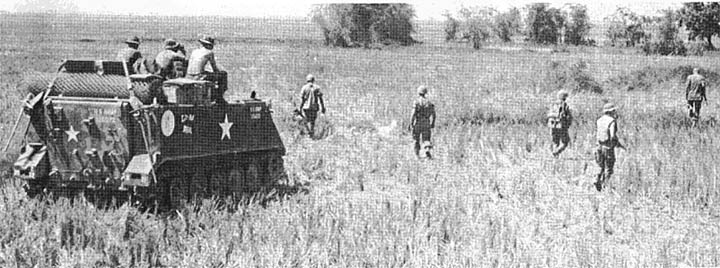 |
| BLOCKING FORCE -- Soldiers of the 2nd Battalion (Mech.), 22nd Infantry search an area surrounding Phu Hoa Dong village during a recent combined forces operation. |
Page 8 TROPIC LIGHTNING NEWS May 11, 1970
Fighting Near Cambodia
Regulars Battalion Overpowers Enemy
TAY NINH - The entire 3rd Battalion, 22nd Infantry, “Regulars” of the 25th
Infantry Division, slashed through a jungle area near the Cambodian border
recently, killing 12 communists and driving through the enemy stronghold.
The week-long operation, approximately eight miles southwest of Tay Ninh
City, began on the southern edge of the jungle area when enemy fire exploded
from the woodline. With the aid of gunships and air strikes, C Company, 3/22nd,
exchanged an awesome volume of fire with the enemy.
“I have never witnessed such fierce contact. We were fighting toe to toe
with the enemy,” said Captain Lawson R. Pride, of Detroit.
While Charlie Company, which had sustained light casualties, was preparing to
be air-lifted, Bravo Company swept toward the contact area. Six enemy bodies
and assorted enemy field gear were uncovered while moving through the enemy
positions; most of which were fortified with three feet of overhead cover.
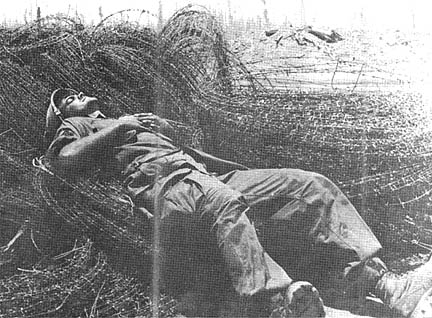 |
BED OF NAILS? -- No he isn’t doing penance, Sergeant David Moore of Republic, Mo., a member of the 25th Division’s 1st Battalion, 27th Infantry “Wolfhounds,” simply could find no better place to take a break from details at Fire Support Base Colorado. (Photo by SP4 Frank Rezzonico) |
125th Signal Bn. Makes It Work
By PFC RICHARD CONNELL
BEARCAT - One of the elements behind a successful military operation is
effective communication. For the 2nd Brigade at Bearcat Base Camp, effective
communication means Charlie Company, 125th Signal Battalion.
Charlie Company is responsible for the communication network running between
the Fire Brigade’s rear element at Bearcat Base Camp to the Forward Command Post
at Fire Support Base Colorado, to the rest of the Brigade’s Fire Support Bases,
and 25th Infantry Division Headquarters in Cu Chi Base Camp.
It is not difficult to understand Charlie Company’s mission, but
understanding how it is accomplished is another matter. If you don’t believe
that statement, try asking Staff Sergeant Joe Norwille of Center Valley, Pa.,
NCOIC of Charlie Company. You are liable to get an answer sounding like it came
word-for-word from an Army Training Manual.
According to Norwille, the Fire Brigade’s communication network contains
something called a TRG-24, a radio, and a carrier called a TECC-7. Or was the
TECC-7 the radio and TRC-24 the carrier? Then there was something about VHF,
wave lengths and channels. Anyway the whole thing comes out sounding rather
technical.
One of the problems with such a complicated system is that there are a lot of
things that can go wrong. Norwille explained, “There are transformers, tubes,
circuits, and a lot of other things that can go out anytime. We have to wait
until they go out to be able to do anything about a bad unit.”
Charlie Company also handles several other important functions. It handles
all the calls that come through the 2nd Brigade’s Loyal phone line, and on a
slow day this means handling several hundred. The signalmen also operate the
Military Affiliate Radio System, better known as MARS radio. This mobile unit,
the only one in the 25th Infantry Division, allows Fire Brigade personnel to
make calls to their families back in the World.
Norwille probably summed up the Function of Charlie Company, 125th signal
Battalion best by saying, “We take a lot of complicated equipment and make it
work.”
Barber Has Right Price
FSB KIEN -- A most unusual sight at a fire support base in the boonies is a
barber shop complete with the traditional candy striped pole at the doorway.
This fire support base, a mile and a half north of Dau Tieng is the home of
the 25th Division’s 2nd Brigade, 12th Infantry, and claims there is such an
establishment.
The man who does the trimming is Private First Class Charles Barton from
Chicago. Barton was a part-time barber before coming into the Army.
When asked what he would have said if someone told him that he was going to
be a barber when he got to Vietnam, Barton replied, “I would have told them they
were crazy.”
And the cost of a haircut? “Whatever price you think is right.” says the
Warrior barber. You can’t beat that.
Giving Charlie High Hell
4 Deuce Has Got a Light
By PFC FRANK SALERNO
CU CHI - The famous author and poet, Rudyard Kipling, once wrote a novel
about men in war called, “The Light That Failed.” For the 25th Division’s 2nd
Battalion (Mech.), 22nd Infantry’s night patrols however, “High Angle Hell”
provides “The Light That’s Never Failed.”
High Angle Hell is a mortar platoon in Headquarters Company of the “Triple
Deuce,” responsible for supporting night operations with illumination. It is
divided into three sections which work both in Cu Chi and in the field.
“A team is on call round the clock,” said Specialist 5 Bob Cummings, a squad
leader from Troy, Mont. “During the night the men sleep by their mortars so that
within seconds “lum” can be placed anywhere needed.”
Though providing illumination is its primary function, High Angle Hell also
fires high explosives when necessary.
The mortar section in Cu Chi is currently constructing new gun positions and
a fire direction center. To insure the accuracy of each gun, a cement base has
been laid to prevent base plate movement when firing. The direction center
contains radios, maps and plotting charts to calculate adjustments to the mortar
tubes.
The job of High Angle Hell never ceases. When not firing, the team members
are busy inspecting and cleaning tubes and radio systems while making sure they
have enough ammo on hand at all times.
“Without quick illumination our patrols wouldn’t be nearly as effective as
they are in blocking the enemy,” said Private First Class Dennis Le Blanc, Bravo
Company machine gunner from Sacremento, Calif. “It’s always there when we need
it.”
For the men of High Angle Hell, “The Light That’s Never Failed” is a story
they’re proud to tell.
| GETTING READY -- Sergeant Larry Watson of Memphis adjusts a mortar tube while Private First Class Rich Trujillo of Salida, Colo., prepares to load. They are members of the 25th Division’s “High Angle Hell” platoon. (Photo by PFC Frank Salerno) |
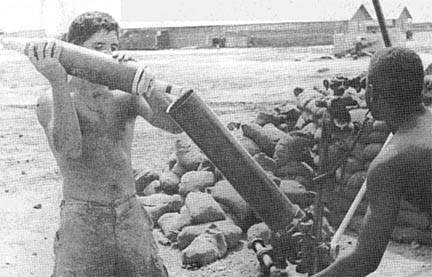 |
Hounding’ Charlie Slows Infiltration
By PFC ROBB LATO
PHUOC LUU - The 25th Division’s Delta Company, 2nd Battalion, 27th Infantry
“Wolfhounds,” has tackled the task of practicing “preventive medicine” on the
disease of enemy infiltration.
The key to this medicine is spelled c-h-e-c-k-p-o-i-n-t.
Captain Paul Evans of Columbus, Ga., Delta Company’s commander, explained
that the purpose of several checkpoints in this small border village was to
prevent enemy infiltrators from crossing into Vietnam.
“But after a few days in the area,” Evans said, “The number of our objectives
increased.”
One of the major problems the “Hounds” had was persuading the village
officials to convince the people to stay away from the border.
“We expected a lot of action because we were so close to the border,” said
Platoon Sergeant Leroy Garrington of Seattle. “But aside from isolated sniper
fire one day, most of our work involved checking civilians.”
Thanks to:
Roger Welt, 4th Bn., 23rd Inf., and a Tropic Lightning News correspondent,
for sharing this issue,
Kirk Ramsey, 2nd Bn., 14th Inf. for creating this page.
This page last modified 04-30-2006
©2006 25th Infantry Division Association. All rights reserved